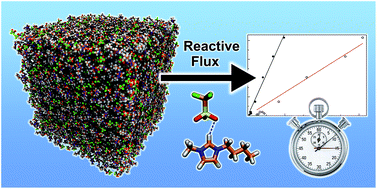当前位置:
X-MOL 学术
›
Faraday Discuss.
›
论文详情
Our official English website, www.x-mol.net, welcomes your
feedback! (Note: you will need to create a separate account there.)
Structure and lifetimes in ionic liquids and their mixtures
Faraday Discussions ( IF 3.3 ) Pub Date : 2017-07-11 00:00:00 , DOI: 10.1039/c7fd00166e Sascha Gehrke 1, 2, 3, 4, 5 , Michael von Domaros 1, 2, 3, 4 , Ryan Clark 6, 7, 8 , Oldamur Hollóczki 1, 2, 3, 4 , Martin Brehm 4, 9, 10, 11 , Tom Welton 6, 7, 8 , Alenka Luzar 12, 13, 14, 15 , Barbara Kirchner 1, 2, 3, 4
Faraday Discussions ( IF 3.3 ) Pub Date : 2017-07-11 00:00:00 , DOI: 10.1039/c7fd00166e Sascha Gehrke 1, 2, 3, 4, 5 , Michael von Domaros 1, 2, 3, 4 , Ryan Clark 6, 7, 8 , Oldamur Hollóczki 1, 2, 3, 4 , Martin Brehm 4, 9, 10, 11 , Tom Welton 6, 7, 8 , Alenka Luzar 12, 13, 14, 15 , Barbara Kirchner 1, 2, 3, 4
Affiliation

|
With the aid of molecular dynamics simulations, we study the structure and dynamics of different ionic liquid systems, with focus on hydrogen bond, ion pair and ion cage formation. To do so, we report radial distribution functions, their number integrals, and various time–correlation functions, from which we extract well-defined lifetimes by means of the reactive flux formalism. We explore the influence of polarizable force fields vs. non-polarizable ones with downscaled charges (±0.8) for the example of 1-butyl-3-methylimidazolium bromide. Furthermore, we use 1-butyl-3-methylimidazolium trifluoromethanesulfonate to investigate the impact of temperature and mixing with water as well as with the chloride ionic liquid. Smaller coordination numbers, larger distances, and tremendously accelerated dynamics are observed when the polarizable force field is applied. The same trends are found with increasing temperature. Adding water decreases the ion–ion coordination numbers whereas the water–ion and water–water coordination is enhanced. A domain analysis reveals that the nonpolar parts of the ions are dispersed and when more water is added the water clusters increase in size. The dynamics accelerate in general upon addition of water. In the ionic liquid mixture, the coordination number around the cation changes between the two anions, but the number integrals of the cation around the anions remain constant and the dynamics slow down with increasing content of the chloride ionic liquid.
中文翻译:

离子液体及其混合物的结构和寿命
借助分子动力学模拟,我们研究了不同离子液体系统的结构和动力学,重点研究了氢键,离子对和离子笼的形成。为此,我们报告了径向分布函数,它们的数量积分以及各种时间相关函数,我们可以利用电抗性通量形式从中提取定义明确的寿命。我们探讨了极化力场与VS的影响。不可极化的带降级电荷(±0.8)的离子,例如1-丁基-3-甲基咪唑鎓溴化物。此外,我们使用1-丁基-3-甲基咪唑鎓三氟甲磺酸盐来研究温度的影响以及与水以及与氯离子液体的混合。当施加极化力场时,观察到较小的配位数,较大的距离和极大的加速动力学。随着温度升高,发现了相同的趋势。加水会降低离子与离子的配位数,而水与离子和水与水的配位则会增强。畴分析表明,离子的非极性部分被分散,当添加更多的水时,水簇的大小会增加。加水后,动力学通常会加速。在离子液体混合物中,
更新日期:2017-12-15
中文翻译:

离子液体及其混合物的结构和寿命
借助分子动力学模拟,我们研究了不同离子液体系统的结构和动力学,重点研究了氢键,离子对和离子笼的形成。为此,我们报告了径向分布函数,它们的数量积分以及各种时间相关函数,我们可以利用电抗性通量形式从中提取定义明确的寿命。我们探讨了极化力场与VS的影响。不可极化的带降级电荷(±0.8)的离子,例如1-丁基-3-甲基咪唑鎓溴化物。此外,我们使用1-丁基-3-甲基咪唑鎓三氟甲磺酸盐来研究温度的影响以及与水以及与氯离子液体的混合。当施加极化力场时,观察到较小的配位数,较大的距离和极大的加速动力学。随着温度升高,发现了相同的趋势。加水会降低离子与离子的配位数,而水与离子和水与水的配位则会增强。畴分析表明,离子的非极性部分被分散,当添加更多的水时,水簇的大小会增加。加水后,动力学通常会加速。在离子液体混合物中,











































 京公网安备 11010802027423号
京公网安备 11010802027423号